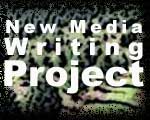In this assignment, you'll conceive, write, and design a prototype of a New Media Project.
This project will explore ways of reconciling the properties of New Media (as analyzed by Janet Murray, or discussed in class through digital examples) with the culturally, aesthetically, intellectually expressive uses of writing exemplified in the especially "written" pieces we've studied in class. In most cases, the project will be  aimed at a particular audience, for whom the subject matter, your presentation of it, and any opportunities to participate in the project will be particularly expressive.
aimed at a particular audience, for whom the subject matter, your presentation of it, and any opportunities to participate in the project will be particularly expressive.
You will use Dreamweaver and Photoshop to produce this prototype, which will consist of a home page, rationale page, and two sample pages--all linked together as a site. Like any prototype, the site is not intended to represent the complete work as may someday exist, but only to illustrate your project's concept, presentation, and procedures in order to suggest how--and for whom--it will have cultural meaning.
The assignment also includes a 500-word-minimum commentary.
Criteria
- that the project consists of a Home Page, Rationale Page, two sample "lexia" (that is, two pages, two blocks of text[s], two units of meaning, which serve as examples for more by you or others), and a 500-word (minimum) written commentary
- how fully the conception and execution of the project recognizes the properties of New Media--while not necessarily obeying them--as defined by Janet Murray's chapter: Procedural, Encyclopedic, Participatory, Spatial (PEPS)
- the extent to which the project implies a dialogue (or dialogues) among competing, contradictory, or contrasting styles, perspectives, contexts, realms of meaning, etc.--as does the poem "The Whitsun Weddings," for example, which--as we discussed in class--mingles the sensory and the spiritual, the man-made and natural, the isolated "I" and communal "we."
- the degree to which the project uses New Media tropes (that is, meaning-invoking "moves" characteristic of New Media)
- the degree to which the project demonstrates the author's technical grasp of the software, techniques, and work flows learned in class so far
- how usably and aesthetically the project is visually designed and presented, including how the pages are linked together
- how thoughtfully the project is analyzed in a formal, well-written, grammatically correct commentary of at least 500 words (about 2 double-spaced pages)
- how well the commentary explains the project's realization of (and/or negotiation with) PEPS
- how well the commentary explains the project's parallels with works of writing studied in class, especially the ways these writings bring unlike styles or perspectives into dialog
- how well the commentary explains the project's parallels with New Media projects discussed in class, including explicit references to New Media tropes.
- whether the commentary includes at least three, well chosen quotations (or very specific descriptions of visual texts) from the class readings (especially Murray's chapter) with page numbers indicated when appropriate, or from online examples
- whether all outside references in the commentary are cited correctly using MLA-style in-text citation format and bibliographic documentation at the end of the commentary.
Hybrids of New Media and Writing Aesthetics:
- Sorry Everybody (2004, after George W. Bush's re-election in the wake of the invasion of Iraq. See also the rationale)
- "Implementation" by Nick Montfort and Scott Rettberg (notice the rationale page)
- PostSecret (blog)